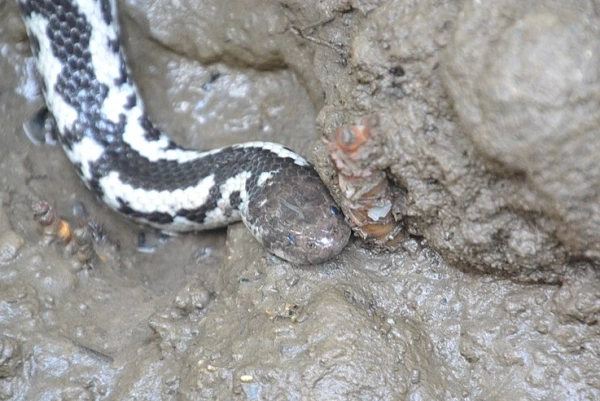In our ongoing series dedicated to decoding nature, one article at a time, we present yet another fascinating piece about white snakes with black spots.
While not exceptionally rare, they are uncommon due to their relatively low frequency of occurrence. White snakes are even less commonly observed in the natural world.
If you happen to encounter a milky white snake, it is highly likely to be an albino. Albino is a hereditary condition characterized by the absence of pigment in the skin and hair.
Here, we have a list of four white snakes with black spots that will certainly catch your attention.
Are There Any White Snakes With Black Spots?
1) White-bellied mangrove Snake

| Scientific Name | Fordonia leucobalia |
| Size | 90 cm |
| Habitat | Mangrove swamps and tropical tidal wetlands |
| Location | Southeast Asia and Northern Australia |
white-bellied mangrove snakes or Crab-Eating Water Snakes are instantly recognizable due to their unique coloration.
Crab-eating snake has a white body which is contrasted by irregularly scattered black spots along their back, creating a visually appealing pattern.
Their distinct coloration serves as a form of camouflage in their mangrove and tidal wetland environment.
Their body and mouth are adapted to feed on crabs found in their habitat.
2) Aberrant California King Snake
| Scientific Name | Lampropeltis californiae |
| Size | 76 – 107cm |
| Habitat | Variety of habitats- woodlands, grasslands, deserts, and suburbs |
| Location | North America |
California King Snake typically displays alternating bands of dark and light colors, which can range from black and white to brown and cream. But here we are talking about Aberrant California King Snake.
The distinct black spots on their white body stay only when they are young. As they grow up, these black spots turn into prominent bands alternating between dark and light creating a very distinct pattern.
California kingsnakes are known for their mimicry of venomous rattlesnakes.
3) Northern Pine Snake
| Scientific Name | Pituophis melanoleucus melanoleucus |
| Size | 120–230 cm |
| Habitat | Pine flatwoods, sandy pine-oak, cultivated field, open brushland, and rocky desert |
| Location | United States |
The belly of the Northern Pine Snake is predominantly white, with rows of black dots or spots running along either side of its white belly.
Like the other species of Pine Snake, the Northern Pine Snake possesses mimicry adaptations.
One of these adaptations is a small filament in their mouth that enables them to produce loud hissing sounds as a form of defense mechanism.
4) Eastern massasauga
| Scientific Name | Sistrurus catenatus |
| Size | 60 to 75 cm |
| Habitat | Variety of places- from grasslands to swamps and marshes |
| Location | North America |
Eastern Massasauga rattlesnakes have a base color ranging from grey to tan with large black or brown spots that cover the center of their body.
While not purely white, the gray color can sometimes appear quite light, giving the impression of a body that is somewhat white with dark spots
Eastern Massasaugas have rattles located at the tip of their tail that when vibrated produce a distinctive clattering sound.
They have specialized heat-sensing pits located on each side of their smallish heads.
Conclusion
This marks the end of another insightful session where we’ve delved into the amazing ways in which nature unveils itself to us.
These 4 snakes are adorned with captivating patterns, not merely for aesthetic purposes, but also as a defense mechanism against potential predators. These patterns serve as a form of mimicry, aiding them in evading their enemies.
Also Read:

Hi everyone, my name is Shawna, and I’ve always been fascinated by the fascinating diversity of flora and fauna that our nature has in it. I am currently studying biotechnology and am particularly interested in animal biotechnology, delving into the intricate processes that define their true nature and uniqueness.
